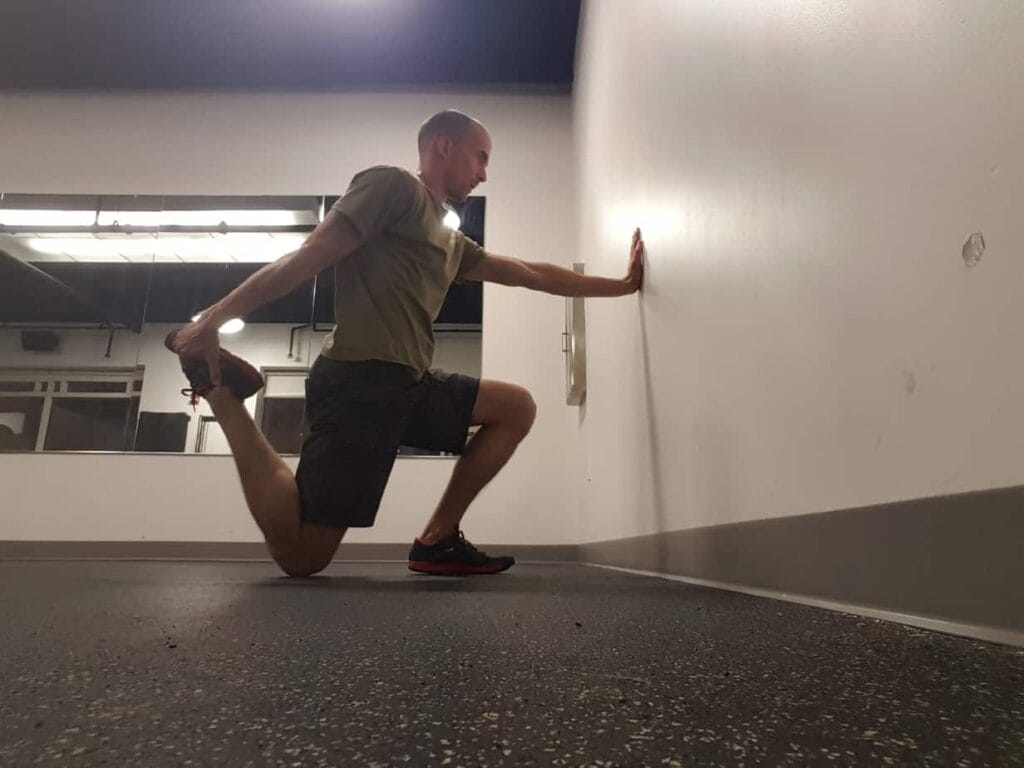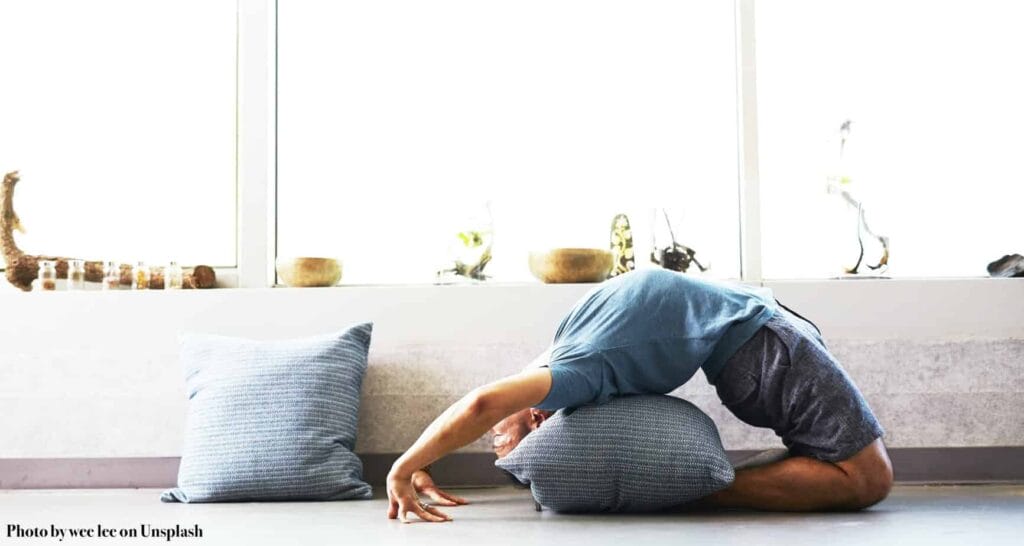Get Some Relief for Your Tight Hip Flexors
Do your hip flexors feel chronically tight no matter how much you stretch them? Do you foam roll them, hoping they’ll loosen up and magically be not tight one day?
You are not alone my friend. Many of us have tight hip flexors.
Hip flexors can be tight for many reasons, so let’s dive into some of them.
Differences in “Tightness”
There are a few classic ways one might feel tightness in their hip flexors.
- Hip flexors are short and tight
- Hip flexors are elongated and tight
- The tightness is due to weakness in the muscles.
Let’s explore the differences.
Short and Tight
This kind of tension is often seen in folks with varying degrees of anterior pelvic tilt (or APT). This is when the pelvis tips down in the front and up in the back. This tilt causes elongated (weak) abdominal and hamstring muscles (which can also feel tight) and at the same time causes short and tight low back and hip flexor muscles. This combination of tight and weak muscles is called lower cross syndrome.
See photo below

One of the two big contributors to APT is too much sitting and not enough movement— especially not enough variety of movement. Many of us have some degree of APT because modern life, unfortunately, has us sitting still a lot of the time.
Elongated and Tight
Another way hip flexors can feel tight is if they’re over-stretched, either from a posterior pelvic tilt (PPT) or from stretching incorrectly. A PPT is when the front of the pelvis tips up, and the back of the pelvis tips down. In this situation, often the abdominals and glutes are tight and the low back muscles and hip flexors are elongated, and often also weak.
Overstretching with incorrect form can cause the ligaments in the front of the hip to become loose; and once loose, ligaments tend not to go back to their previous state. Loose ligaments don’t support the joint in the same way, so the muscles around the joint step in to help by tightening up.

Note to my hypermobile peeps!
If you have hyper-mobility in your joints, no matter which way your pelvis tilts, your muscles may be tight because the ligaments and joint capsules are naturally lax. In this case, your tight muscles actually create some needed joint stability. But there are other ways stabilize the joint that also allow those hip flexors to calm down.
What to do to get some relief
The following exercises are geared toward those with anterior pelvic tilt (APT) in their posture. If you have a posterior pelvic tilt and you are looking for exercises or stretches, reach out— we’re here to help. For my hypermoible friends, many of these exercises will help you to strengthen around your hip joint.
Foam Rolling Quads
Foam rolling can help our muscles feel less tight by bringing oxygenated blood to those tissues.
The hip flexors are the just below the hip bone you feel on the front of your body. For 30 seconds, place the foam roller in your hip crease and roll up and down about the length of two to three inches. Then, for 30 seconds, start at the outside of your hip and roll in towards the pubic bone (sorry, there is no video to show this!).
The video shows how to foam roll the quads. You may find it helpful to watch from 1:26 onward to see how to foam roll all the leg muscles, but for our purposes, focus on the quads for 30 seconds.
Stretch the Hip Flexors and Quads
Hold each stretch in this sequence for 5 long breaths or about 30-60 seconds. If you are hypermobile, you can skip the stretching, or if you prefer to stretch, hold for only 10 seconds on each side.
You can also add a quad stretch to the True Hip Flexor Stretch. Follow the same set up from the video above, but elevate your foot on a couch, chair or bench. The closer your knee is to your elevated surface, the more intense the stretch can be. Find what works best for you— just remember to tuck the hips under, squeeze the glute really strong, and align the ribs over your pelvis. And no arching your back!
In the photo below, Mike demonstrates this stretch by holding his own foot while supported by the wall. Holding your own foot is an option, but only if you can do it with your pelvis tucked under (no crease at the front of your hip) and no arch in your low back.

Strengthen the places that are weak
With APT, you’ll want to strengthen your glutes, abs and hamstrings, because these are the muscles that elongated. Try these three exercises.
Single Leg Hip Lift-for your glutes
Hold one knee close to your torso and drive straight down with your opposite heel. Make sure the knee doesn’t pull away from your torso as you lift your hips.
Heel Bridge-for your hamstrings
Gently drive your heels straight into the floor. Hold for 5 long breath cycles, with long exhales.
Dead Bug-for your abs/core
The purpose of this exercise to to create a lot of abdominal tension especially as you challenge your core by reaching your arm and leg away without arching your back or losing alignment, like a soup can. Crush your yoga block between your hand and your knee (don’t just use your fingertips to hold the block). Crush the yoga block like it’s a bug-pull the knee up into the chest and press the knee down. This creates a lot of isometric contraction in your abs. Hold that tension throughout the exercises. If you are feeling shaky, you’re doing it right!
Bonus exercises
These next two exercises are a great addition for my hypermobile friends or for those that find lifting their knee up to their torso difficult. This is where strengthening your hip flexors may be helpful in alleviating the tightness, because tight muscles aren’t always strong (more often they are weak).
Start with the half kneeling hip flexor strengthener then work on the straight leg lift. Each of these exercises strengthens the hip flexors in a different way.
To perform this exercise place your foot up on an elevated surface. Contract your core and make sure your ribs are aligned over your pelvis and you are not arching your back. Core must remain super contracted as well as the glute of the standing leg. Image you are a volcano erupting— the lava is bubbling out from your core into the rest of your body, but don’t let it escape! Maintaining that tension throughout the body (that lava spill) by contracting all your muscles (except your neck and face) and creating fist.
On an exhale, think about gently floating your foot off your surface and then lowering with control. Your surface only needs to be as high as you can lift one to two inches and then lower.
Putting it all together
Here’s a nice little template to follow.
- Foam roll hip flexors and quads, or all your leg muscles, for about 30 seconds each.
- Stretch, if you need to, for 30 seconds for 5 long breath cycles. If you’re hypermobile, stretch for only 10 seconds, but preferably not at all.
- Strengthen things:
- Glutes with single leg hip lifts: do 5-10 reps on each leg
- Hamstrings with heel bridge: hold that press into the floor for 5 long breaths.
- Abdominals with dead bugs: do 5-8 reps on each side. Use a long exhale as you extend away.
- Bonus exercises-start with the first exercise, progress to the second.
- Hip flexor strengthener-perform 8-10 reps on each side
- Standing straight leg leg lift-do 8-10 on each leg
A recommendation
I recommend doing these every day to help alleviate your hip flexor tension. Once you know the routine it should only take 10 minutes. But you can also sprinkle these stretches and exercises throughout your day. If you find you’ve been sitting for a long time, get up, do some foam rolling, stretching and maybe the single leg hip lift for 5 reps. The more application you give your body the better.
The order of each stretch and exercise is important. It’s designed to first mobilize and stretch out the tissue and then activate and strengthen the muscles that are weakened due to the posture. Additionally, if you are strength training, adding these stretches and exercises to your warm up can help you get more from your sessions. Lastly, doing these exercises and then strengthening the glutes, abs, and hamstrings with additional exercises can help to pull the pelvis out of APT (although it is a never ending struggle if you sit a lot!).
Just remember to try to break up some of the sitting with standing and moving around and adding the above stretches and exercises and hopefully this will bring you some relief.
If you need more assistance we’re always happy to answer your questions. Hit us up here. If you want more detailed assistance we offer in-person and online training.
Looking for some more guidance with your fitness journey? Schedule your FREE fitness consultation strategy session with one of our coaches. In this 30-minute Zoom or in the studio session we’ll talk with you about your fitness hopes and dreams and share how we can assist you in reaching your goals.


Pingback: Tips for Tight Hamstrings - Reimagym